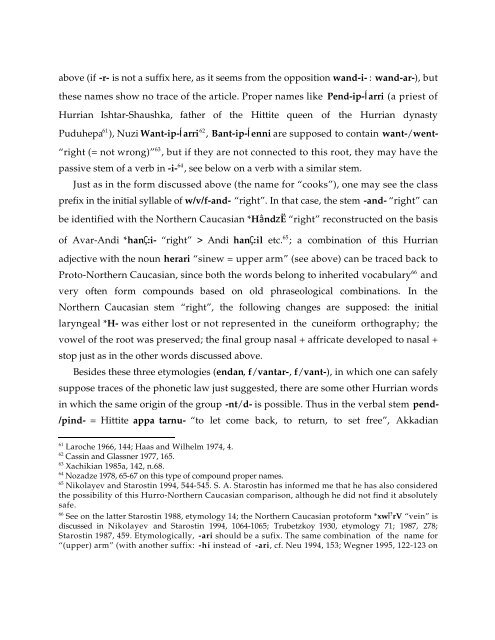Comparative Notes on Hurro-Urartian, Northern Caucasian
Comparative Notes on Hurro-Urartian, Northern Caucasian
Comparative Notes on Hurro-Urartian, Northern Caucasian
Create successful ePaper yourself
Turn your PDF publications into a flip-book with our unique Google optimized e-Paper software.
above (if -r- is not a suffix here, as it seems from the oppositi<strong>on</strong> wand-i- : wand-ar-), but<br />
these names show no trace of the article. Proper names like Pend-ip-Íarri (a priest of<br />
Hurrian Ishtar-Shaushka, father of the Hittite queen of the Hurrian dynasty<br />
Puduhepa 61 ), Nuzi Want-ip-Íarri 62 , Bant-ip-Íenni are supposed to c<strong>on</strong>tain want-/went-<br />
“right (= not wr<strong>on</strong>g)” 63 , but if they are not c<strong>on</strong>nected to this root, they may have the<br />
passive stem of a verb in -i- 64 , see below <strong>on</strong> a verb with a similar stem.<br />
Just as in the form discussed above (the name for “cooks”), <strong>on</strong>e may see the class<br />
prefix in the initial syllable of w/v/f-and- “right”. In that case, the stem -and- “right” can<br />
be identified with the <strong>Northern</strong> <strong>Caucasian</strong> *Hând´zË “right” rec<strong>on</strong>structed <strong>on</strong> the basis<br />
of Avar-Andi *hanÇ:i- “right” > Andi hanÇ:il etc. 65 ; a combinati<strong>on</strong> of this Hurrian<br />
adjective with the noun herari “sinew = upper arm” (see above) can be traced back to<br />
Proto-<strong>Northern</strong> <strong>Caucasian</strong>, since both the words bel<strong>on</strong>g to inherited vocabulary 66 and<br />
very often form compounds based <strong>on</strong> old phraseological combinati<strong>on</strong>s. In the<br />
<strong>Northern</strong> <strong>Caucasian</strong> stem “right”, the following changes are supposed: the initial<br />
laryngeal *H- was either lost or not represented in the cuneiform orthography; the<br />
vowel of the root was preserved; the final group nasal + affricate developed to nasal +<br />
stop just as in the other words discussed above.<br />
Besides these three etymologies (endan, f/vantar-, f/vant-), in which <strong>on</strong>e can safely<br />
suppose traces of the ph<strong>on</strong>etic law just suggested, there are some other Hurrian words<br />
in which the same origin of the group -nt/d- is possible. Thus in the verbal stem pend-<br />
/pind- = Hittite appa tarnu- “to let come back, to return, to set free”, Akkadian<br />
61 Laroche 1966, 144; Haas and Wilhelm 1974, 4.<br />
62 Cassin and Glassner 1977, 165.<br />
63 Xachikian 1985a, 142, n.68.<br />
64 Nozadze 1978, 65-67 <strong>on</strong> this type of compound proper names.<br />
65 Nikolayev and Starostin 1994, 544-545. S. A. Starostin has informed me that he has also c<strong>on</strong>sidered<br />
the possibility of this <strong>Hurro</strong>-<strong>Northern</strong> <strong>Caucasian</strong> comparis<strong>on</strong>, although he did not find it absolutely<br />
safe.<br />
66 See <strong>on</strong> the latter Starostin 1988, etymology 14; the <strong>Northern</strong> <strong>Caucasian</strong> protoform *xwî ? rV “vein” is<br />
discussed in Nikolayev and Starostin 1994, 1064-1065; Trubetzkoy 1930, etymology 71; 1987, 278;<br />
Starostin 1987, 459. Etymologically, -ari should be a sufix. The same combinati<strong>on</strong> of the name for<br />
“(upper) arm” (with another suffix: -hi instead of -ari, cf. Neu 1994, 153; Wegner 1995, 122-123 <strong>on</strong>





